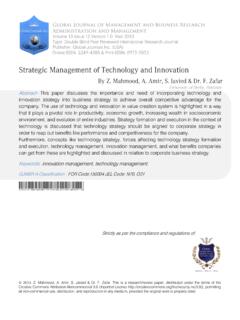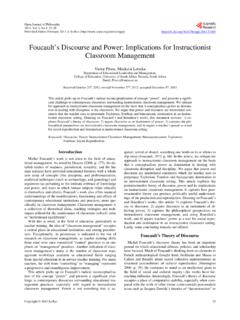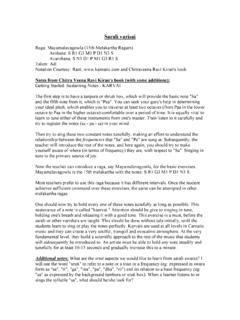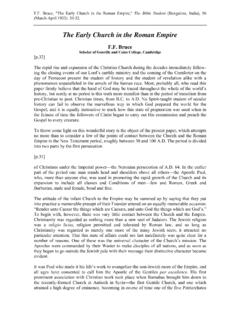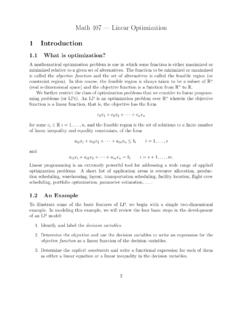Transcription of Barriers to Strategy Implementation by Mid Sized ...
1 Global Journal of Management and Business Research Administration and Management Volume 13 Issue 12 Version Year 2013 Type: Double Blind Peer Reviewed International Research Journal Publisher: Global Journals Inc. (USA) Online ISSN: 2249-4588 & Print ISSN: 0975-5853 Barriers to Strategy Implementation by Mid Sized Companies in Kenya Jomo Kenyatta University of Agriculture and Technology, Kenya Abstract- This paper builds on previous studies and examines the Barriers to Strategy Implementation by mid Sized companies in Kenya. The study looks closely at the Barriers which can either be internal; management, communication, human factors such as resistance to change, leadership, organizational structure, information systems and technology or external factors; changes to the operating environment, un-anticipated competition or entrants by new players in the industry and changes in government policies.
2 It further recommends ways on how to overcome these Barriers . Keywords: internal Barriers , external Barriers , Strategy Implementation , mid Sized companies. GJMBR-A Classification : FOR Code:150304 JEL Code: M00 BarrierstoStrategyImplementationbyMidSiz edCompaniesinKenya Strictly as per the compliance and regulations of: By Madegwa Andrew Lihalo K. Andrew Lihalo is a research/review paper, distributed under the terms of the Creative Commons Attribution-Noncommercial Unported License ), permitting all non-commercial use, distribution, and reproduction inany medium, provided the original work is properly to Strategy Implementation by Mid Sized Companies in Kenya Madegwa Andrew Lihalo K.
3 Abstract- This paper builds on previous studies and examines the Barriers to Strategy Implementation by mid Sized companies in Kenya. The study looks closely at the Barriers which can either be internal; management, communication, human factors such as resistance to change, leadership, organizational structure, information systems and technology or external factors; changes to the operating environment, un-anticipated competition or entrants by new players in the industry and changes in government policies. It further recommends ways on how to overcome these Barriers . Keywords: internal Barriers , external Barriers , Strategy Implementation , mid Sized companies. I. Introduction a) Concept of Strategy ll mid size companies in Kenya know where they are, where they want to be in some years to come and what actionsto take in order to get there.
4 They have clear and elaborate plan of their vision and mission statement. According to Johnson and Scholes (2002), as quoted by Musyoka, (2011), Strategy is the direction and scope of an organization over the long-term, which achieves advantage for the organization through its configuration of resources within a challenging environment, to meet the needs of markets and to fulfil stakeholder expectations. In other words, Strategy is about: where the business is trying to get to in the long-term; the markets it should invest in and the kind of activities involved in such markets; how the business can perform better than the competitors in those markets; the resources (skills, assets, finance, relationships, technical competence, facilities) required to enable it to compete; the external environmental factors that affect the business ability to compete, and the values and expectations of those who have power in and around the business.
5 She further state that Strategy is often conceptualized as a term for operating at both the corporate and competitive level. b) Strategy Implementation Strategy Implementation is process or paths that an organization takes in order to be or reach where it sees itself in the future. It s the process or path that leads to where the organization sees itself in the future. Musyoka, (2011)argues thatStrategy Implementation is largely an internal administrative activity. It entails working through others, organizing, motivating, culture Author: Jomo Kenyatta University of Agriculture and Technology, Mombasa CBD Campus. e-mail: cr eating strong links between Strategy and how the organization operates.
6 It also entails a process of converting the formulated strategies into viable operations that will yield the organization s targeted results. She further argues that delicate and sensitive issues are involved in Strategy Implementation , such as resource mobilization, restructuring, cultural changes, technological changes, process changes, policy and leadership changes. The changes can be adaptive (calling for installation of known practices), innovative (introducing practices that are new to adopting organizations) or radically innovative (introducing practices new to all organizations in the same business or industry) (Byars et al.)
7 , 1996). c) Barriers to Strategy Implementation Source: Niven (2002: 11) Figure 1 : The Barriers to Implementing Strategy Barriers are those factors that obstruct, prevent, block or hinder in the process of Strategy Implementation . These factors are an impediment or stumbling block thus making it hard for the organization to achieve or to realise its goals of being where it want to be in the years to come. The Barriers to Strategy Implementation can either be by internal or external sources within an organization. These Barriers are dependent on the type of Strategy , type of organization and prevailing circumstances which can be avoided if Strategy development is coupled with Implementation .
8 The lack of understanding of a Strategy and the inability to connect Strategy formulation and Implementation has an impact on successful Implementation . d) In ternal Sources This is the biggest barrier to Strategy Implementation in mid size companies in Kenya. The A 2013 Global Journals Inc. (US)9 Global Journal of Management and Business Research Volume XIII Issue XII Version IY2013ear ( )Ast affs are complacent where they are and will resist any strategic changes being introduced by the organization. They would rather maintain the status quo than embrace the unknown changes introduced into the organization. Systemic Barriers results when the organization indirectly does not support a Strategy thus leading to the process of Strategy Implementation lagging behind.
9 Also issues such as unanticipated problems arising at the time of Strategy Implementation , when Strategy Implementation goes beyond the planned time, rigid and bureaucratic organizational structure and insufficient financial resources to execute the Strategy form part of systemic Barriers . For any Strategy to be fully implemented, it requires well trained and competent manpower. But the cost of training the staff, lack of qualified people to train and limitation in time may act as a barrier to Strategy Implementation . A times Strategy , Implementation is resisted because it was introduced by certain managers and so the staff try to oppose him through resisting anything he introduces or when the staff realises they stand to loose if the existing structures are done away with.
10 Resistance to change normally leads to delays, additional costs and destabilizes organization change process. People working in an organization sometimes resist change proposals and make Strategy difficult to implement (Lynch, 2000). Behavioural Barriers may be exhibitedat an individual or group level in an organization. Mistrust, Narrow-mindedindividuals self interest, misunder- standing, intolerance and formed opinions give rise to the behavioural Barriers . Lacks of direction from manager s leads to employees not knowing what the organization is expecting from them. Also apart of the employees could have built their own goals aligned to the organizational goals.



